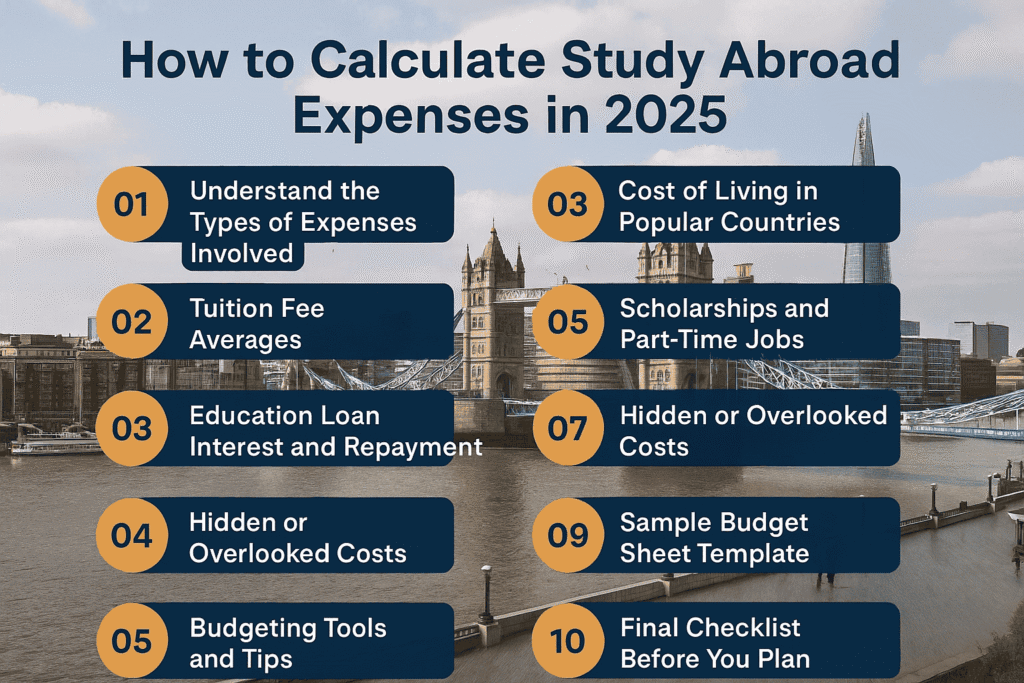Studying abroad is a dream for many Indian students, but proper financial planning is crucial to make it a reality. In 2025, understanding the full scope of study abroad expenses can help you prepare better, reduce surprises, and manage funds wisely. This guide breaks down everything you need to consider when calculating your total study abroad cost—from tuition to hidden expenses.
1. Understand the Types of Expenses Involved
Studying abroad includes several types of costs:
-
Tuition Fees: Varies based on country, course, and university.
-
Application Fees: For universities, exams (IELTS, GRE, etc.), and visa.
-
Accommodation: On-campus housing or off-campus rental.
-
Living Expenses: Food, transportation, utilities, mobile/internet, etc.
-
Health Insurance: Mandatory in many countries.
-
Travel Costs: Airfare, visa charges, local transportation.
-
Books & Supplies: Academic materials and equipment.
-
Miscellaneous: Personal items, entertainment, emergency funds.
2. Tuition Fee Averages (2025)
While amounts differ widely by country and course, here’s a general idea:
-
USA: Public universities are more affordable than private ones.
-
UK: Postgraduate degrees tend to be shorter, reducing overall costs.
-
Canada: Competitive fees with high quality of education.
-
Germany: Public universities often charge minimal or no tuition.
-
Australia: Higher fees but offers work while studying.
Tip: Always visit the official university website for updated fee structures.
3. Cost of Living in Popular Countries
Use cost of living calculators like:
Examples:
-
USA (New York): ₹1,20,000–₹1,60,000/month
-
UK (London): ₹1,00,000–₹1,40,000/month
-
Canada (Toronto): ₹90,000–₹1,20,000/month
-
Germany (Berlin): ₹70,000–₹90,000/month
4. Currency Exchange and Inflation in 2025
Currency fluctuations can impact your planning. Use reliable sources for live conversion rates like:
Plan a 10–15% buffer for inflation or unexpected hikes.
5. Scholarships and Part-Time Jobs
To manage costs better:
-
Scholarships: Look for merit-based, need-based, or country/university-specific ones.
-
Part-Time Jobs: Many countries allow students to work up to 20 hours/week.
6. Education Loan Interest and Repayment
Most Indian students rely on education loans. Consider:
-
Loan interest rate (ranges between 8–12%)
-
Processing fees and moratorium period
-
Government interest subsidy schemes (e.g., CSIS)
Check providers like:
7. Hidden or Overlooked Costs
-
Local transportation passes
-
Sim card or internet setup
-
Entry/Exit taxes (some countries charge them)
-
Vaccinations or medical exams
-
Unforeseen expenses (e.g., urgent travel, extra books, security deposits)
8. Budgeting Tools and Tips
Use free apps like:
-
Splitwise: Track shared expenses
-
Mint: Manage personal budgeting
-
Google Sheets: Custom tracking of all categories
Tips:
-
Break annual cost into monthly goals
-
Maintain 3–6 months of emergency funds
-
Look for student discounts wherever possible
9. Sample Budget Sheet Template (Monthly)
| Category | Estimated Cost (in INR) |
|---|---|
| Rent | ₹40,000 |
| Food | ₹20,000 |
| Utilities | ₹5,000 |
| Travel | ₹8,000 |
| Internet/Mobile | ₹2,000 |
| Entertainment | ₹5,000 |
| Misc. | ₹5,000 |
| Total | ₹85,000 |
Adjust based on location and lifestyle.
10. Final Checklist Before You Plan
✅ Compare tuition fees and living costs by country
✅ Use real-time converters and add buffers
✅ Explore all scholarship options early
✅ Get clarity on loan repayment terms
✅ Have digital and physical backups of all financial docs
✅ Set a savings target and track progress monthly
Conclusion
Studying abroad is a big investment, but smart planning makes it achievable. With the right budgeting strategies, access to scholarships, and understanding of hidden costs, students from India can turn their dream of studying abroad into a reality in 2025.

